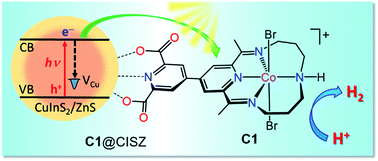Charge transfer dynamics and catalytic performance of a covalently linked hybrid assembly comprising a functionalized cobalt tetraazamacrocyclic catalyst and CuInS2/ZnS quantum dots for photochemical hydrogen production†
Abstract
Although the cobalt complex, [Co(CR)X2]+ (CR = 2,12-dimethyl-3,7,11,17-tetraazabicyclo[11.3.1]heptadeca-1(17),2,11,13,15-pentaene), has been studied as a catalyst for electro- and photochemical H2 generation and CO2 reduction for more than thirty years, only the unfunctionalized one was used as a free catalyst in bulk solutions. Considering that the immobilization of functionalized molecular catalysts (MCs) on the surface of light harvesting materials through a stable covalent linkage was often an effective strategy to boost the activity of semiconductor/MC hybrid photocatalytic systems, we prepared the first anchoring group-functionalized [Co(CR)X2]+ complex (C1, X = Br), which bears a (2′,6′-dicarboxypyridin-4′-yl) group at position 15 of the macrocyclic ligand. The covalent attachment of C1 to the surface of CuInS2/ZnS (CISZ) core–shell quantum dots (QDs) afforded the C1@CISZ hybrid assembly. Comparative studies on the visible-light-induced H2 evolution performances of C1@CISZ and the non-bonded reference system comprising the unfunctionalized [Co(CR)Br2]+ complex (C2) and CISZ QDs (denoted as C2+CISZ) revealed that the photocatalytic activity of C1@CISZ was twice to thrice as high as that of C2+CISZ under the same conditions. Appealingly, the isolated C1@CISZ assembly was more stable than the C2+CISZ system in long-term photolysis. Moreover, photoluminescence (PL) and transient absorption (TA) spectroscopic studies demonstrated that covalent immobilization of C1 on the surface of CISZ QDs accelerated the electron transfer from QDs to the catalyst and meanwhile retarded the charge recombination process on the surface of QDs. The evidently improved charge separation efficiency resulted in the higher activity of the hybrid assembly C1@CISZ than that of C2+CISZ for photocatalytic hydrogen production.



 Please wait while we load your content...
Please wait while we load your content...